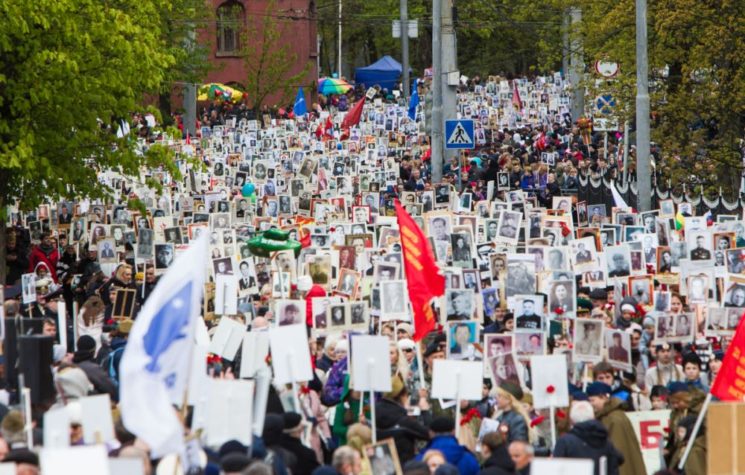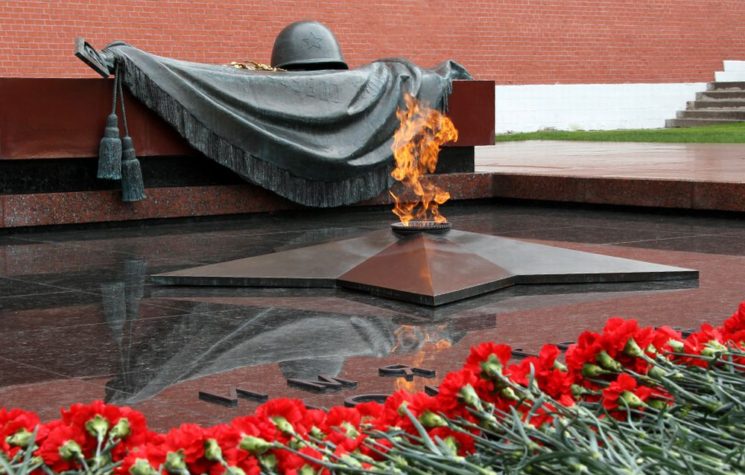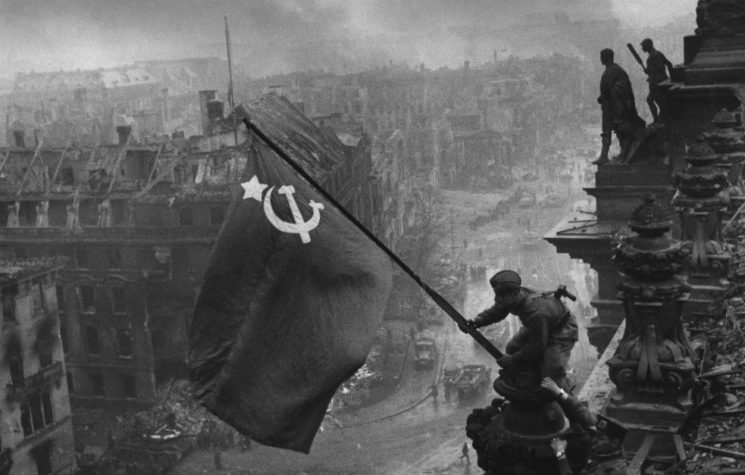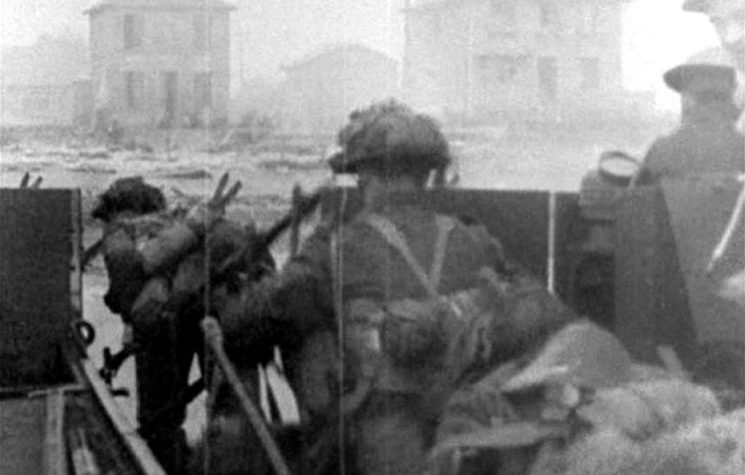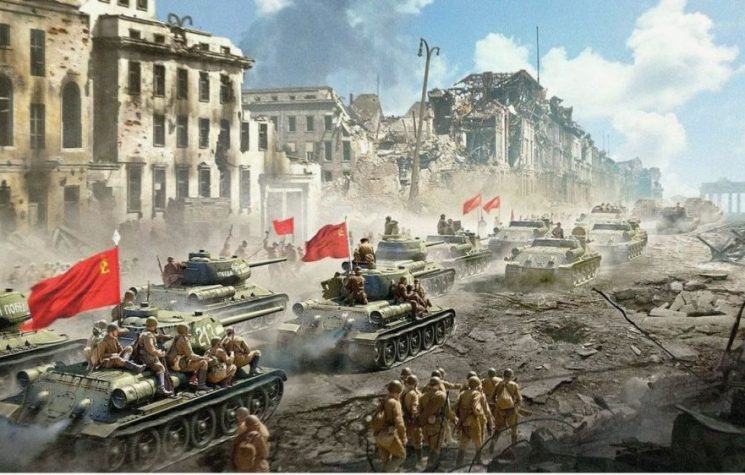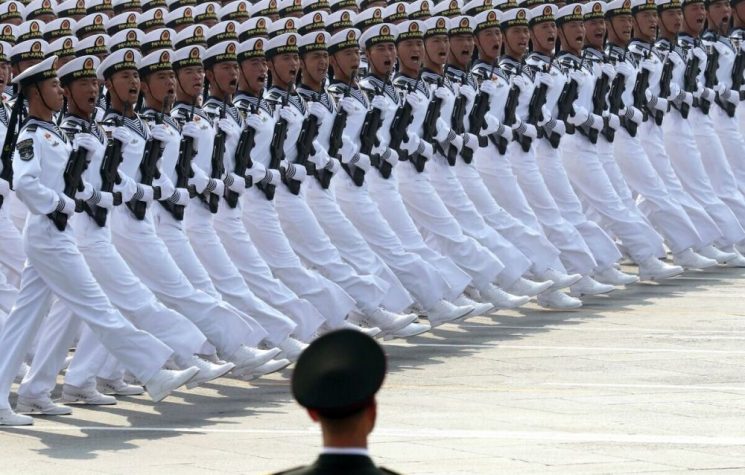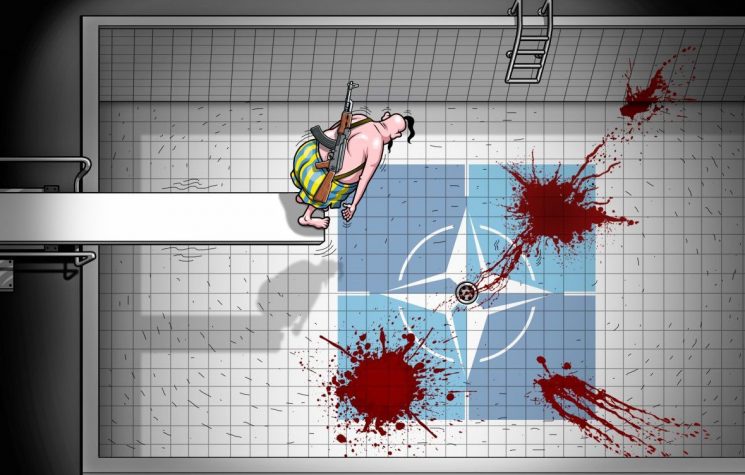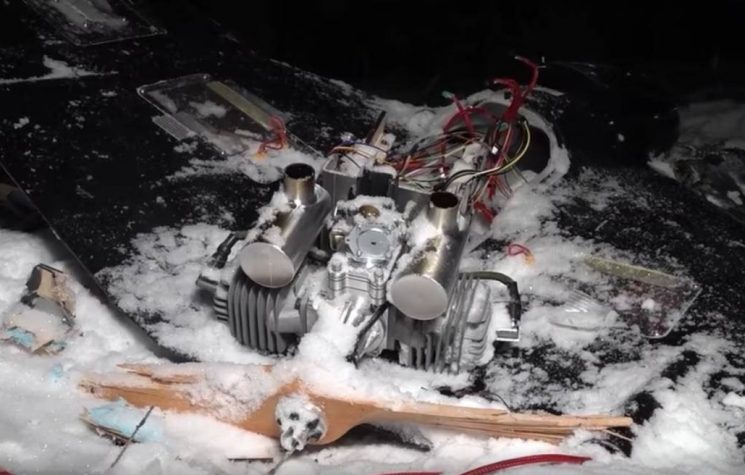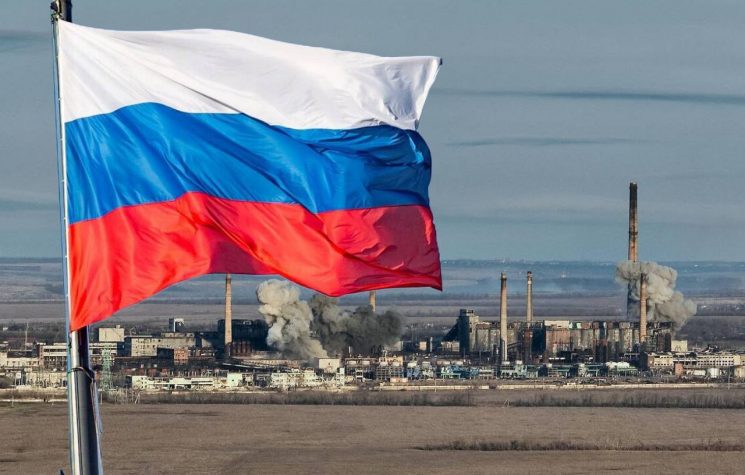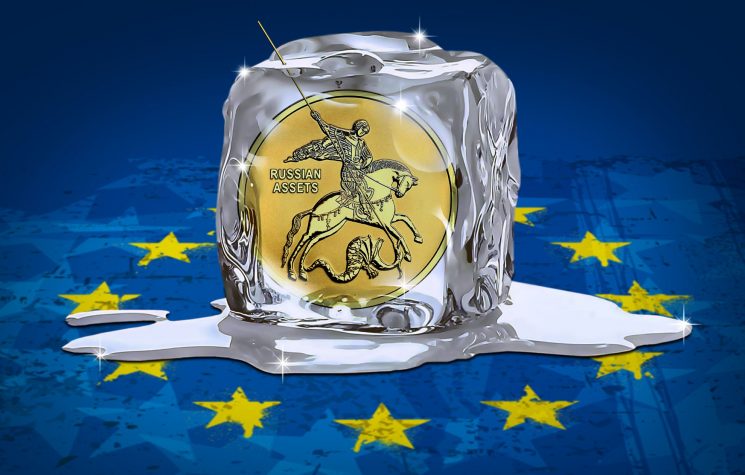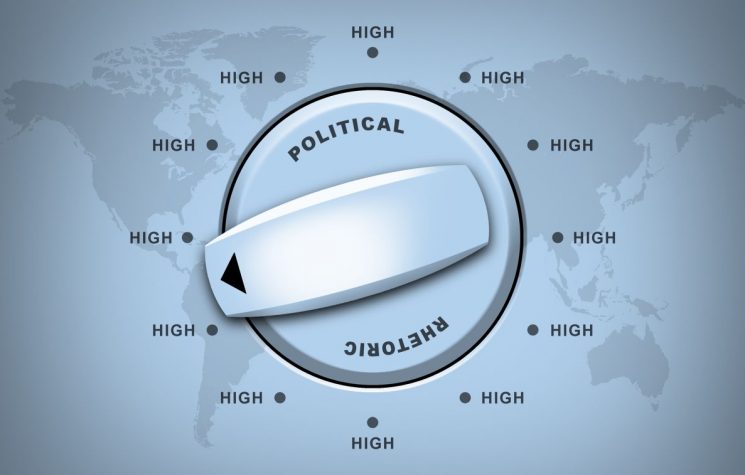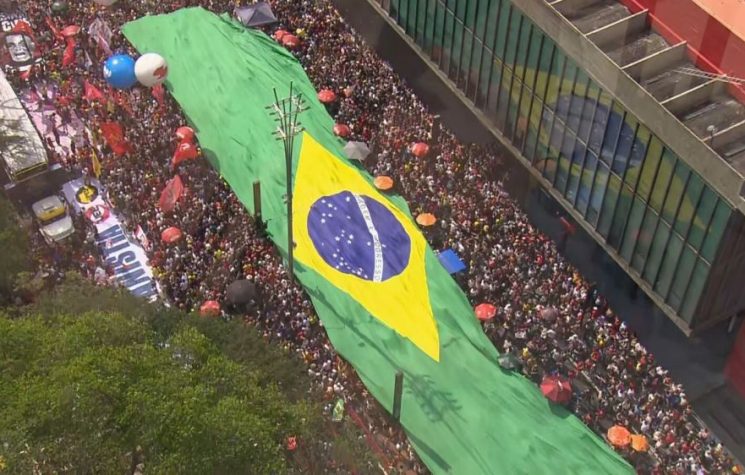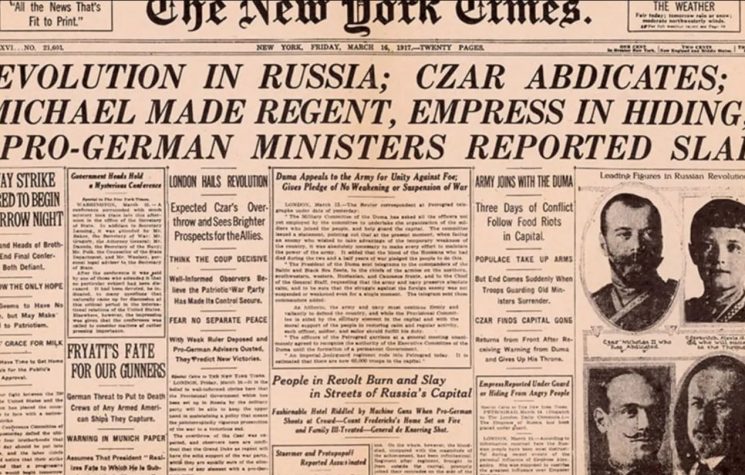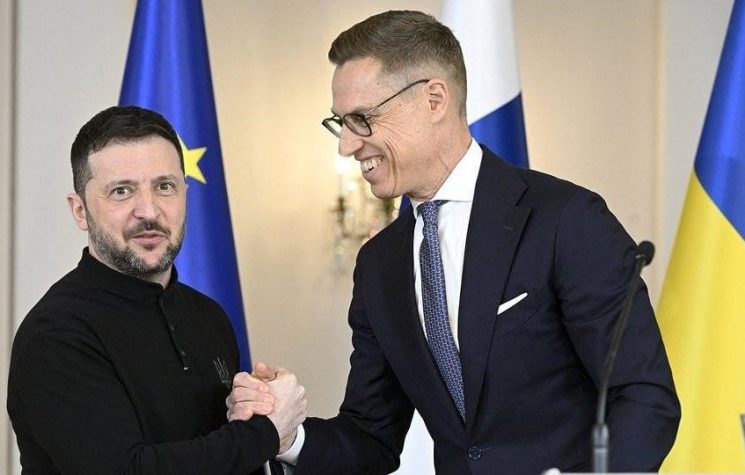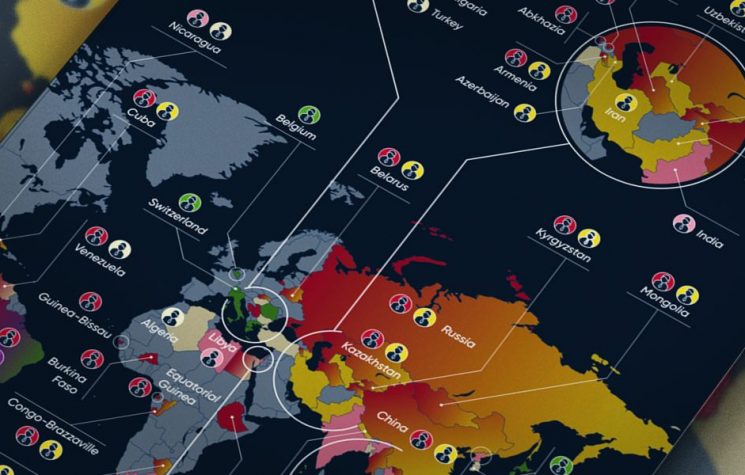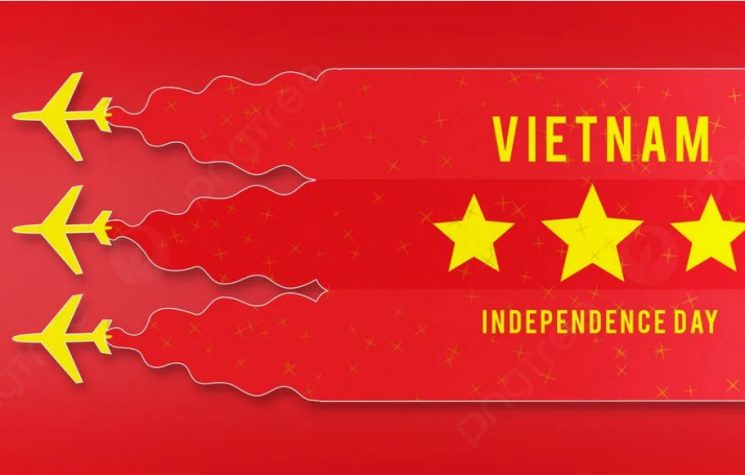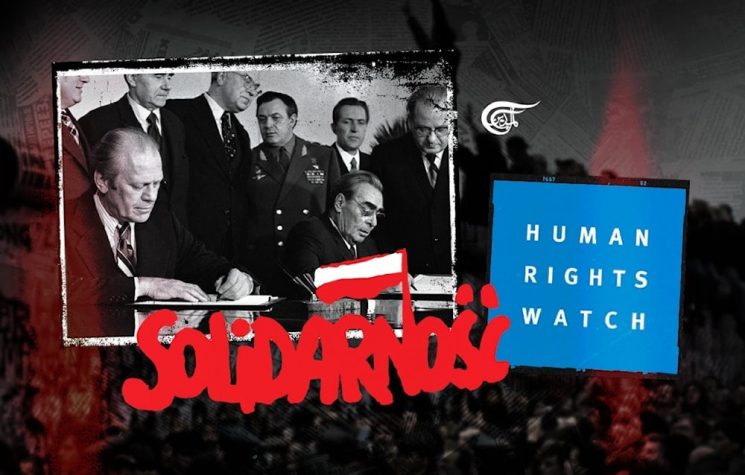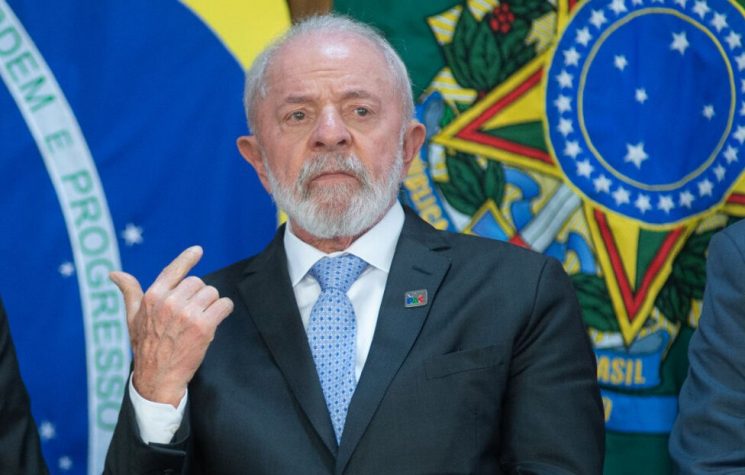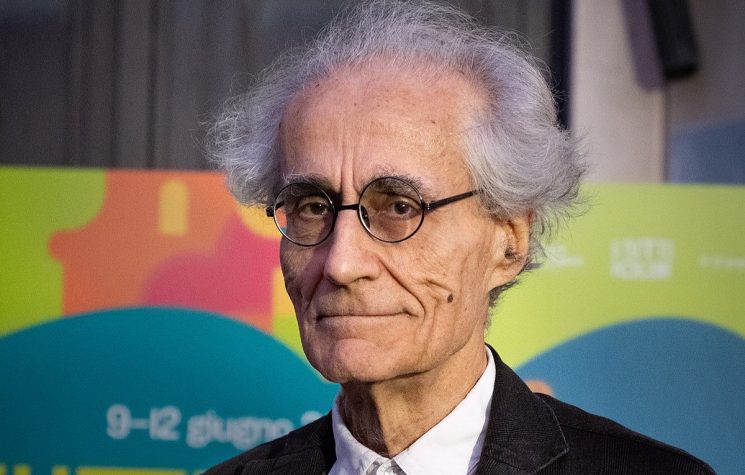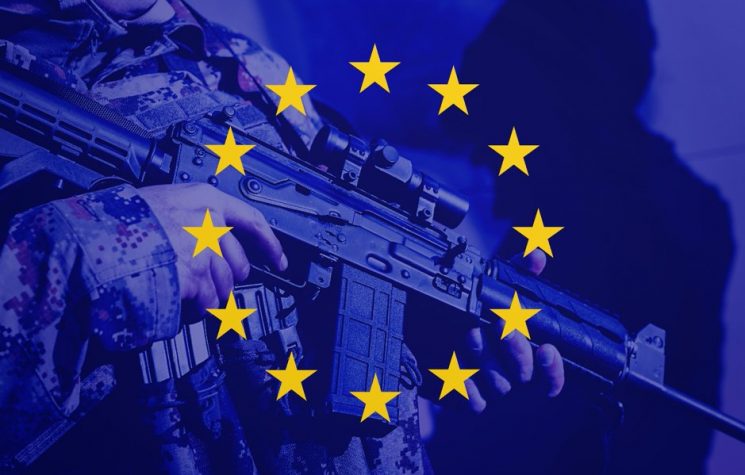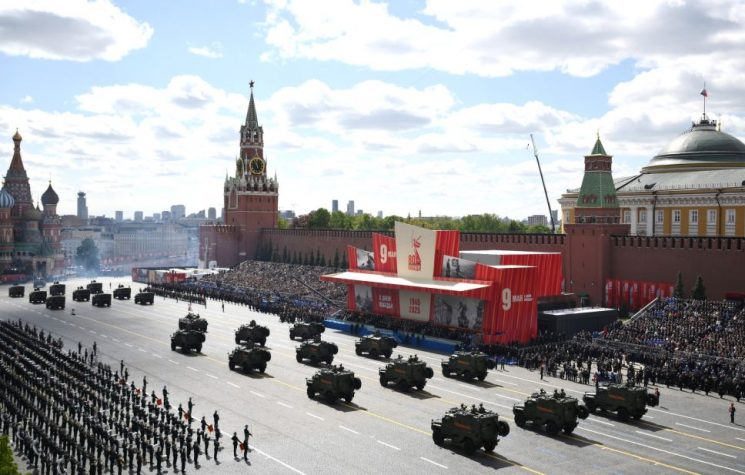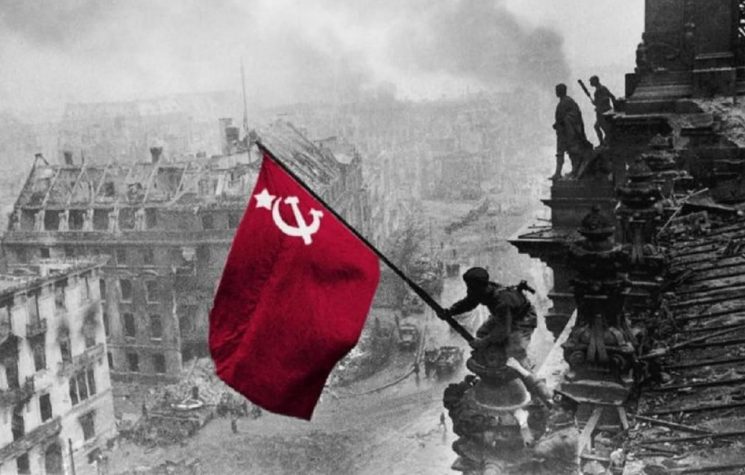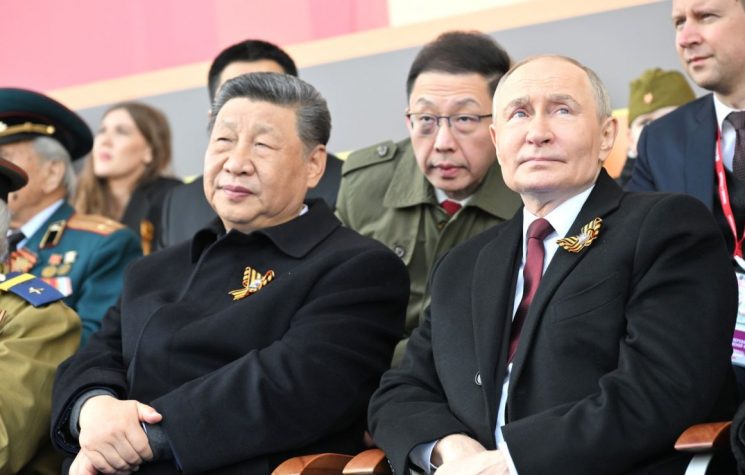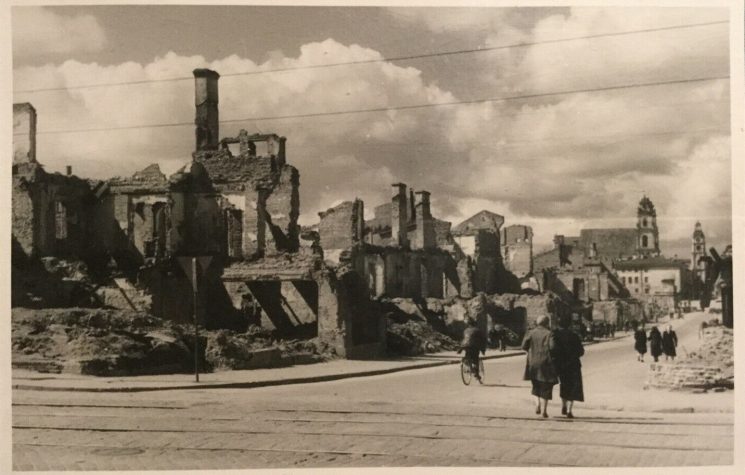What is Victory Day ?
Every spring, as the weather improves, Russians begin to venture outside to enjoy the warming sun, or perhaps to open up their dachas or to prepare vegetable gardens for planting. There is also the long May holiday to anticipate. This year however is different. Like almost everywhere else in the world, Russia has been hit by the coronavirus. It means people are asked to stay in their flats and not go out except for necessities, like groceries, prescriptions, and the like. It is a time of worry, frustration, aggravation. In short, this year the May holiday is not going to be a holiday at all, at least not as it usually is. The traditional 9 May celebrations, the parade in Red Square and the marches around Russia of the Bessmertnyi polk are postponed. President Putin has indicated that these events will be held as soon as the coronavirus danger has passed. For now, anyway, instead of streets and parks full of people, remembering the brave deeds of veterans and of their own family members, public places will be empty.
That does not mean that anyone should forget the meaning of 9 May and why Russians celebrate it. May 9th is Victory Day, den’ pobedy. On that day in 1945 Marshal Georgy Konstantinovich Zhukov, commander of the 1st Belorussian Front, which had stormed Berlin, received the German unconditional surrender. The Great Patriotic War had gone on for 1418 days of the most unimaginable violence, brutality and destruction. From Stalingrad and the northern Caucasus and from the northwestern outskirts of Moscow to the western frontiers of the Soviet Union to Sevastopol in the south and Leningrad and the borders with Finland, in the north, the country had been laid waste. An estimated 17 million civilians, men, women and children, had died, although no one will ever know the exact figure. Villages and towns were destroyed; families were wiped out without anyone to remember them or mourn their deaths. Some ten million Soviet soldiers perished in the struggle to expel the monstrous Nazi invader and finally to track it down in Berlin at the end of April 1945. Red Army dead were left unburied in a thousand places along the routes to the west or interred in unmarked mass graves, there having been no time for proper identification and burial. Of the male children born between 1922 and 1924 in the USSR, three out of a hundred survived the war. Most Soviet citizens lost family members. No one was left unaffected.
“Whoever comes to us with a sword, from a sword will perish.”
The Great Patriotic War began at 3:30am on 22 June 1941, when the Nazi Wehrmacht invaded the Soviet Union along a front stretching from the Baltic to the Black Seas with 3.2 million German soldiers, organised in 150 divisions, supported by 3,350 tanks, 7,184 artillery pieces, 600,000 trucks, 2,000 warplanes. Finnish, Italian, Romanian, Hungarian, Spanish, Slovakian forces, amongst others, eventually joined the attack. The German high command reckoned that Operation Barbarossa would take 4 to 6 weeks to finish off the Soviet Union. In the west, U.S and British military intelligence agreed. Besides, what force had ever beaten the Wehrmacht? Nazi Germany was the invincible colossus. Poland had been crushed in a few days. In April 1940 the Anglo-French attempt to defend Norway was a fiasco. The Germans walked into Denmark. In May the Wehrmacht attacked in the west, Holland disappeared and Belgium hurried to quit the fight. France collapsed in a few weeks. The British army was driven out of Dunkirk, naked, without guns or Lorries. In the spring of 1941, Yugoslavia and Greece disappeared in a matter of weeks at little cost to the German invaders.

The Wehrmacht felt the bite of the battered but not beaten Red Army. German forces were taking 7,000 casualties a day, a new experience for them.
Wherever the Wehrmacht advanced in Europe, it was a walkover… until that day German soldiers stepped across Soviet frontiers. The Red Army was caught flatfooted, in halfway measures of mobilisation, because Soviet “boss”, I. V. Stalin, did not want to provoke Hitlerite Germany. The result was a catastrophe. But unlike Poland and unlike France, the USSR did not quit the fight after the expected 4 to 6 weeks. The Red Army’s losses were unimaginable, two million soldiers lost in the first three and a half months of the war. The Baltic provinces were lost. Smolensk fell and then Kiev, in the worst Soviet defeat of the war. Leningrad was encircled. An old man asked some soldiers, “Where are you retreating from?” There were calamities everywhere. But at places like the fortress of Brest and in hundreds of unnamed locations, road junctions, villages and towns, Red Army units fought on often to the last soldier. They fought out of encirclements to rejoin their own lines or to disappear into the forests and swamps of Belorussia and the northwestern Ukraine to organise the first partisan units to attack the German rear. By the end of 1941, three million Soviet soldiers were lost (2/3s being POWs who the Germans allowed to starve to death); 177 divisions were struck from the Soviet order of battle. Still, the Red Army fought on, even forcing back the Germans at Yelnya, southeast of Smolensk, at the end of August. The Wehrmacht felt the bite of the battered but not beaten Red Army. German forces were taking 7,000 casualties a day, a new experience for them.
As the Wehrmacht advanced, Einsatzgruppen, SS death squads, followed, killing Jews, Roma, communists, Soviet POWs, or anyone who got in their way. Baltic and Ukrainian Nazi collaborators assisted in the mass murders. Soviet women and children were stripped naked and forced to queue, waiting for execution. When winter came, freezing German soldiers shot villagers or forced them out of their homes, dressed in rags like beggars, robbing them of hearth, winter clothing and anything to eat.
In the west those who predicted a speedy Soviet collapse, the usual western Sovietophobes, looked stupid and had to eat their forecasts. Public opinion understood that Hitlerite Germany had walked into a quagmire, not another cake walk in France. While the British everyman cheered on Soviet resistance, the British government did relatively little to help. Some Cabinet ministers were even reluctant to call the Soviet Union an ally. The prime minister, Winston S. Churchill, refused to let BBC play the Soviet national anthem, the Internationale, on Sunday evenings along with those of other allies.
The Red Army still retreated, but kept fighting. This was no ordinary war, but a struggle of unparalleled violence against a murderous invader for home, family, country, for life itself. Any weapon would do in this fight: a knife, a sharpened spade, an axe, a brick to kill the enemy. In November the Red Army dropped a pamphlet on German lines, quoting Carl von Clausewitz, the Prussian military theorist: “It’s impossible either to hold or conquer Russia.” That was real bravado in the circumstances, but also true. One Soviet war poster recalled the 13th century grand prince Aleksandr Nevsky’s famous line: “Whoever comes to us with a sword, from a sword will perish.” Every Russian school child could repeat it by heart: Кто с мечом к нам придёт; от меча и погибнет. There was something indomitable in the Russian spirit, something intangible in the Russian national character, shaped by history, environment, geopolitics, and passed on from generation to generation, which explains the Red Army’s refusal to quit the fight against the Hitlerite colossus. A Soviet poet, Vasily Ivanovich Lebedev-Kumach, wrote the words to what became the most important hymn of the war, Sacred War (Священная война), calling people to resistance against the fascist hordes. The hymn is played for the march of the colour guard in Red Square on Victory Day. People still stand even now when they hear it played at the theatre. Listen to the words and music; it is hard not to show emotion.
It was the same with poet and war correspondent Konstantin Mikhailovich Simonov’s poem “Wait for me”. Frontoviki, soldiers at the front, often kept a copy with them for luck and could recite the verses by heart. It begins like this: “Wait for me and I’ll come back! Wait with all your might! Wait when dreary yellow rains tell you nothing’s right; Wait when snow is falling fast; Wait when summer’s hot; When no one waits for other men…” For some ten million Red Army soldiers no waiting could ever bring them home; and that was the unspoken pathos of Simonov’s poem.
The Battle for Moscow: Nazi invincibility is shattered forever
Finally, in front of Moscow, in December 1941, the Red Army, under Zhukov’s command, threw back the spent forces of the Wehrmacht, in the south by as much as three hundred kilometres. The image of Nazi invincibility was shattered. Barbarossa was too ambitious, the blitzkrieg had failed, and the Wehrmacht suffered its first strategic defeat. In London Churchill agreed, grudgingly, to let BBC play the Soviet national anthem.

In December 1941, the Red Army shattered the image of Nazi invincibility.
In 1942 the Red Army continued to suffer defeats and heavy losses, as it fought on nearly alone. In November of that year at Stalingrad on the Volga, the Red Army launched a counteroffensive, which led to a remarkable victory and the retreat of the Wehrmacht back to its start lines in the spring of 1942… well, except for the German Sixth Army, caught in the Stalingrad kotel or cauldron. There, 22 German divisions, some of Hitler’s best, were destroyed, along with Romanian, Italian and Hungarian armies. Stalingrad was the Verdun of the Second World War. “It’s hell,” a soldier said. “No… this is ten times worse than hell,” someone else corrected. To live through a day of fighting in Stalingrad, that was something. “It would be great to get to Kiev,” one soldier said. “… To Berlin,” replied another. “Be patient, we’ll get there,” I imagine someone else saying. At the end of the winter fighting in 1943, Axis losses were stupendous: 100 German, Italian, Romanian, Hungarian divisions were destroyed, or mauled. The president of the United States, Franklin D. Roosevelt, reckoned that the tide of battle had turned: Hitlerite Germany was doomed. The frontoviki knew it too.

A Soviet soldier in Stalingrad.
The tide of battle had turned, but where were the Western allies?
It was February 1943. In that month there was not a single British, American, or Canadian division fighting in Europe against the Wehrmacht. Not one. It was sixteen months before the Normandy landings. The British and Americans were then fighting two or three German divisions in North Africa, a sideshow compared to the Soviet front. Western public opinion knew who was carrying the burden of the war against the Wehrmacht. In 1942, 80% of Axis divisions were arrayed against the Red Army. At the beginning of 1943 there were 207 German divisions on the Eastern Front. Let’s say that the western allies’ 1.5 % share of the burden of ground fighting against the Wehrmacht was not an equal distribution of sacrifice. Churchill knew this and to assuage a sometimes guilty conscience, liked to point to Anglo-American bombing of Germany. Winston also knew that fighting on the ground was far, far more costly in human lives than fighting in the air or at sea.
The Germans tried one last offensive against the Kursk bulge in July 1943. That operation failed. The Red Army then launched a counteroffensive sweeping across the Ukraine which led to the liberation of Kiev in November. Further north, Smolensk, the western gateway to Moscow, was freed the month before.
The spirit of the Soviet people and their Red Army was formidable. War correspondent Vasily Semenovich Grossman captured its essence in his journals. “Night, Snowstorm,” he wrote in early 1942, “Vehicles, Artillery. They are moving in silence. Suddenly a hoarse voice is heard. ‘Hey, which is the road to Berlin?’ A roar of laughter.”

Women fought alongside the men as snipers, gunners, tankists, pilots, nurses partisans.
Soldiers were not always brave. Sometimes they fled. “A battalion commissar armed with two revolvers began shouting, ‘Where are you running you sons of whores, where? Go forward, for our Motherland, for Jesus Christ, motherfuckers! For Stalin, you whores!’…” They went back to their positions. Those fellows were lucky; the commissar could have shot them all. Sometimes he did. A soldier volunteered to execute a deserter. “Did you feel any pity for him?” Grossman asked. “How can one speak of pity,” the soldier replied. At Stalingrad seven Uzbeks were found guilty of self-inflicted wounds. They were all shot. Grossman read a letter found beside a dead Soviet soldier. “I miss you very much. Come and visit us. I wish I could see you, if only for an hour. I am writing this, and tears are falling. Daddy, please come home and visit.”
Women fought alongside the men as snipers, gunners, members of tank crews, pilots, nurses partisans. They also kept the home front going. “Villages have become the kingdom of women,” wrote Grossman, “They drive tractors, guard warehouses and stables… Women are carrying on their shoulders the great burden of work. They dominate… send bread, aircraft, weapons and ammunition to the front.” When the war was being fought on the Volga, they did not reproach their men for having given up so much ground. “Women look and say nothing,” wrote Grossman, “… not a bitter word.” But in the villages near the front, sometimes they did.
The British and Americans still haven’t opened the second front. “What kind of allies are they?”
In the meantime, the western allies attacked Italy. Stalin had long demanded a second front in France, which Churchill resisted. He wanted to attack the Axis “soft underbelly”, not to help the Red Army, but to hinder its advance into the Balkans. The idea was to advance quickly up the Italian boot, then wheel eastward into the Balkans to keep out the Red Army. The way to Berlin however was north northeast. Churchill’s plan was a failure; the western allies did not get to Rome until June 1944. There were approximately 20 German divisions in Italy fighting against larger allied forces. In the East, there were still more than two hundred Axis divisions, or ten times those in Italy. That increased the Anglo-American share of the burden of fighting against the Wehrmacht from 1.5% to 10%, a large increase for the western allies.
On 6 June 1944 when Operation Overlord began in Normandy, the Red Army stood on Polish and Romanian frontiers. A fortnight after the Normandy landings, the Red Army launched Operation Bagration, a huge offensive which stove in the centre of the German eastern front, destroyed or mauled 28 German divisions, and led to an advance of some 600 kilometres to the west, while the western allies were still held up on the Normandy peninsula. Operation Bagration was fueled by 130 divisions; Overlord by 20. The western allies were starting to pull their weight: of the 150 divisions engaged that summer of 1944 on the western and eastern fronts, their share rose to 14%. Americans of course say that Overlord was “decisive”. In fact, it was an anti-climax, an impressive operation to be sure, but not decisive. Mind you, Stalin was not complaining, he was pleased to have the second front even if, by his reckoning, it was late in the war.
At the beginning of August the Red Army units found themselves in the eastern outskirts of Warsaw. Could they take the Polish capital? The Polish Home Army (Armia Krajowa), an underground resistance movement, thought they could. Under the control of the Polish government in exile in London, the Home Army, calculating that the Wehrmacht was planning to abandon the Polish capital, attacked German forces on 1 August 1944. It launched this operation without advising the Red Army high command. The objective was to take control of Warsaw before the arrival of the Red Army and to re-establish the authority of the so-called London Poles. This was not an action intended to help the Red Army, but rather to hinder its operations by re-establishing the authority of the pre-war anti-Soviet Polish government.
Since 1943 the Red Army had become an unstoppable juggernaut, and the idea that the London Poles could have denied control of Warsaw to Soviet forces is delusional. The Poles also miscalculated on German intentions. The Wehrmacht decided to hold Warsaw, and in this situation the poorly armed Polish forces had no chance. They called for assistance from U.S and British forces and from the Red Army which they despised. So much so, that the Home Army sometimes attacked isolated Red Army units.
Poles and Russians had many reasons to hate or mistrust one another, dating back six centuries. In 1919-1920 they fought a war over the contested borderlands between Warsaw and Moscow. During the interwar years the Soviet side made overtures for better relations, rejected by the Polish government. In January 1934 Poland signed a non-aggression pact with Germany and became a spoiler of Soviet proposals for collective security and mutual assistance against Nazi aggression. The Red Army high command reckoned Poland a potential German ally in the event of war. In 1938 Poland was an ally or at least an accomplice of Hitler in the dismemberment of Czechoslovakia before becoming his victim eleven months later. The Nazi-Soviet non-aggression pact should be considered the direct result of the Munich accords and more generally of the failure of Soviet collective security policy dating from the end of 1933 and rejected by Paris and London. After the collapse of organised Polish resistance against the Nazi invasion in mid-September 1939, the Red Army moved into eastern Poland eventually to annex Belorussian and Ukrainian territories taken by the Poles in 1919-1920. A “stab in the back”, according to the London Poles, but they were in no position to accuse anyone of treachery. In the spring of 1940 Soviet security forces on orders from Moscow shot several thousand Polish officers and government officials judged to be irreconcilable enemies of the Soviet state. No doubt they were, but you could hardly blame the London Poles for their outrage when they learned in 1943 of the executions, discovered and publicised by Nazi authorities in an attempt to break up allied unity. You could also hardly blame Churchill and Roosevelt for not falling for the Nazi strategy. “If they [the Polish officers] are dead,” Churchill remarked, “they could not be resurrected.” These events consolidated a rupture of relations between the USSR and the London Polish government in exile. Moscow was correct to consider the London Poles as irreconcilable enemies. In early 1944 Soviet authorities did not know whether a postwar Poland would be a friend or foe, but they would not sit idly by and allow a hostile government to be set up in Warsaw.

In mid-September the Red Army and allied First Polish Army did try to break into Warsaw.
The Soviet high command was furious with the London Poles, who had created a military and political mess for them, but it would be wrong to accuse the Red Army of sitting on its hands while Poles in Warsaw fought alone against the Wehrmacht. In the rush to the west the Red Army had overrun its lines of supply; it needed to rest and refit. Soviet forces could not take Warsaw off the march, nor was the Polish front the only Soviet military priority. Nevertheless, in mid-September the Red Army and allied First Polish Army did try to break into Warsaw. The Soviet air force flew almost 5,000 sorties to support resistance in Warsaw of which half were to drop supplies. At the beginning of October the Soviet high command recognised that it could not then take Warsaw, and a short time later surviving Polish insurgents surrendered to the Germans.
It was just a matter of time, however, before the destruction of Nazi Germany. Warsaw fell to the Red Army and allied Polish forces in January 1945. Poland was liberated from the Nazi occupiers at the cost of 600,000 Red Army soldiers. When the war was over in May 1945, the Red Army had accounted for 80% of the losses of the Wehrmacht, and that percentage would have been far higher before the Normandy invasion. “Those who never experienced all the bitterness of the summer of 1941,” wrote Vasily Grossman, “will never be able fully to appreciate the joy of our victory.”

Soviet soldiers at Reichstag, May 1945.
Historians often debate about when the decisive turn of battle came in the European theatre. Some propose 22 June 1941, the day that the Wehrmacht crossed Soviet frontiers. Others point to the battles of Moscow, Stalingrad, or Kursk. During the war western public opinion seemed more supportive of the Red Army than some western leaders, Churchill, for example. Roosevelt was better, a more pragmatic political leader, who easily recognised the preponderant Soviet role in the war against Nazi Germany. Even Winston did in his better moments. The Red Army, FDR said to one doubtful general in 1942, was killing more German soldiers and smashing more German tanks than all the other allies put together. Roosevelt knew that the Soviet Union was the linchpin of the anti-Nazi coalition in Europe. I call FDR the godfather of the “grand alliance”, cementing it together with “Lend-Lease” war matériel. Nevertheless, in the shadows lurked the usual haters of the Soviet Union, who were only biding their time before emerging again. The greater the certainty of victory over Nazi Germany, the more vocal and strident became the naysayers of the grand alliance.
Americans are touchy about the memory of the Red Army playing the lead role in the destruction of the Wehrmacht. “What about Lend-Lease,” they say, “without our supplies, the Soviet Union could not have beaten the Germans.” In fact, most Lend-Lease supplies did not arrive in the USSR until after Stalingrad. Red Army soldiers facetiously called the Lend-Lease food tins “second front” since the real one was late in coming. In 1942 Soviet industry was already out-producing Nazi Germany in major categories of armaments. Was the T-34 an American, or a Soviet tank? A polite Stalin always remembered to thank the U.S government for the jeeps and Studebaker trucks. They increased Red Army mobility. “You contributed the aluminum,” Russians famously replied: “we contributed the blood… the rivers of blood.”
There are some great lines in the Russian TV series Istrebiteli. “I have a question for you,” says a young Red Army pilot to his politruk (political commissar). Davai, nods the politruk. “The Soviet people have been fighting for three years… And they [Britain and the United States] still haven’t opened the second front. What kind of allies are they?” The politruk did not reply. Did he need to?
No sooner was the war over than those same “allies” started to think about another war, this time against the Soviet Union. In May 1945 the British high command produced Operation “Unthinkable”, a top secret plan for an offensive, reinforced by German POWs, against the Red Army. What bastards! In September 1945, the Pentagon contemplated use of 204 atomic bombs to destroy the Soviet Union. The godfather, President Roosevelt, had died in April, and within weeks American Sovietophobes were reversing his policy. The grand alliance was only a truce in a Cold War which had begun after the Bolshevik seizure of power in November 1917, and which resumed in 1945.
In that year the U.S. and British governments still had to contend with public opinion. The everyman in Europe and the United States knew very well who had carried the load against the Wehrmacht. You could not resume the old policy of hatred against the Soviet Union just like that without blotting out the memory of the Red Army’s role in the common victory over Nazi Germany. So memories of the Nazi-Soviet non-aggression in August 1939 were brought out of the closet, although the memories of prior Anglo-French opposition to Soviet proposals for collective security against Nazi Germany and especially of the betrayal of Czechoslovakia were omitted from the new western narrative. Like thieves in the night, Britain and the United States burgled the true account of the destruction of Nazi Germany. The fight was on in the west to remember the Soviet Union for the non-aggression pact and to forget the Red Army’s colossal role in smashing the Wehrmacht.
How many of you have not seen some Hollywood film in which the Normandy landings are the great turning point of the war? “What if the landings had failed,” one often hears? “Oh…, not much,” is the appropriate reply. The war would have gone on longer, that is true, and the Red Army would have planted its flags on the Normandy beaches coming from the east. Then there are the movies about the Allied bombing campaign against Germany, the “decisive” factor in winning the war. In Hollywood films about World War II, the Red Army is invisible. It is as if Britain and the United States were claiming laurels they did not earn… like soldiers wearing medals for valour which belonged to others.
The truth is uphill work in a western world where “fake news” and now “fake history” are the norm. The OSCE and European Parliament put the blame for World War II on the Soviet Union, read Russia and President Vladimir Putin, as the subliminal message. Hitler is almost forgotten in this welter of evidence-free accusations. Behind the fake historical narrative are the Baltic states, Poland, and the Ukraine, spewing out hatred of Russia. The Baltics and the Ukraine now remember Nazi collaborators as national heroes and celebrate their vile deeds. In Poland, for some people, this is hard to swallow; they remember the Ukrainian Nazi collaborators who murdered tens of thousands of Poles in Volhynia. Unfortunately, such memories have not stopped Polish hooligans from vandalising monuments to Red Army war dead or desecrating Soviet war cemeteries. Now the Polish government is demolishing the monuments. Polish “nationalists” cannot bear the memory of the Red Army freeing Poland from the Hitlerite invaders.

Russian WWII veterans.
In Russia, however, the west’s mendacious propaganda has no effect. The Soviet Union produced its own films, and the Russian Federation also, about World War II, most recently about the defence of the Brest fortress and of Sevastopol, and the battle of Stalingrad. On 9 May every year Russians remember the millions of soldiers who fought and died, and the millions of civilians who suffered and died at the hands of the Nazis. The veterans, fewer each year, come out wearing uniforms that don’t fit quite right or threadbare jackets covered with war medals and orders. “Treat them with tact and respect,” Zhukov wrote in his memoirs: “It is a small price after what they did for you in 1941-1945.” How did you manage, I wondered to myself observing them on Victory Day some years ago, how did you cope, living constantly with death and so much sorrow and hardship?

Residents of St. Petersburg carry portraits of their ancestors on Victory Day
Now, each year on Victory Day the “immortal regiment”, the bessmertnyi polk, marches; Russians in cities and towns across the country, and abroad, march together carrying large photographs of family members, men and women, who fought in the war. “We remember,” they want to say: “and we will never forget you.” In this battle over memories, the west cannot win.
(This article was first published in Polish in Sputnik Polska.)








